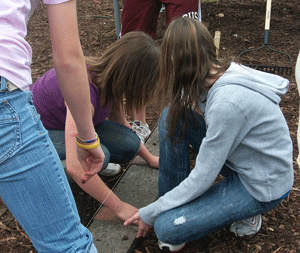 |
|
Interactive Math Garden |
Host a Bug Festival! Also available ...
Our Helping Hands
Project Leaders
|
 The Interactive Math Garden was developed in Spring 2010 as a new addition to our Nature Center. It
was been designed with specific features that
could be used for math lessons at each grade level.
Students had the opportunity to explore real-world applications of math in the world around them. The Interactive Math Garden was developed in Spring 2010 as a new addition to our Nature Center. It
was been designed with specific features that
could be used for math lessons at each grade level.
Students had the opportunity to explore real-world applications of math in the world around them. To fund the project, we received a $500 grant from the Logan, Mason, Menard Regional Office of Education, along with generous donations from our Helping Hands (see list at right) provided the resources to fund this project. Eighth-grade students and Science Club members provided the man power needed to create the math garden and its features. Sadly, our math garden was condensed into our established garden areas as funding was cut to maintain the expanded garden area. The lessons provided below will hopefully inspire other math gardens in other schools who can expand on our ideas.
Also available ...
Math Garden Goals Math Garden Features & Lessons Planting Beds Lessons: Estimatation Challenge - Students measure their hands, feet, and stride to help them estimate the permiter of the planting beds in the gardenb. The download provides worksheets for both metric and English units. Powerpoints for each lesson are also available (metric or English) Figure This - Students use the planting beds for a lesson related to measurements, perimeter, and area. Sunflower, Watermelon, & Pumpkin Patches Lesson: Sunflower Math Challenge - Students use sunflowers for measurement, perimeter, and area lessons. They are also challenged to estimate the number of seeds on their sunflower. Memorial Tree Shape Sculptures & Mobiles Lesson: Shape Sorter - Students use shape mobiles for measurement, perimeter, and area lessons. They also use the shapes to investigate angles and other relationships between polygons. Stepping Stone Axis Garden Borders Resources: The Mini Math Cards will also be used to create a set of reference cards for students to use in the classroom and the garden. A larger Mega Math Card is also available. Weather Station Sundial
Check out our Photo Gallery (Start to Finish)... If you have any questions about the Interactive Math Garden project, please contact Mrs. Tracy (Trimpe) Tomm, project coordinator!
| Back to top |
|
|
|
Privacy Policy © 1999-2025 sciencespot.net |
The Science Spot was developed in March 1999 by
Tracy
Tomm, former Science Teacher @
Havana Junior High, Havana, IL. Activities,
lessons, & worksheets available on
any page of this web site are
intended for use by a single teacher
in his/her classroom or to share at
educational conferences. Reproduction for commercial use or
profit is not permitted without the
consent of
Tracy (Trimpe) Tomm. Visit my
Frequently Asked Questions page for more details. |